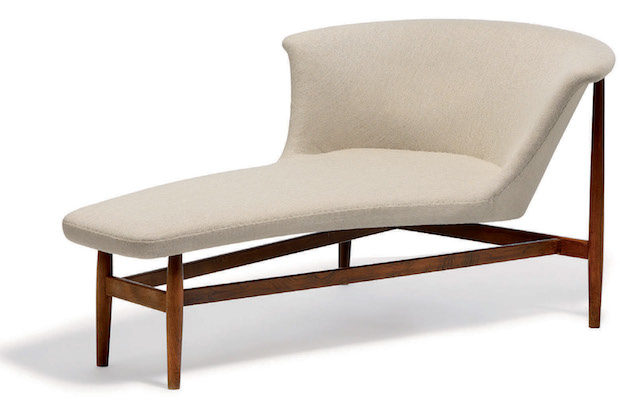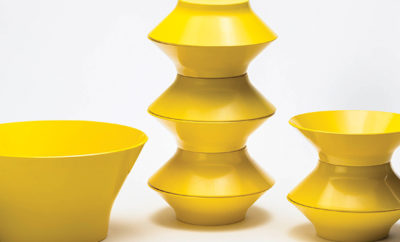 BRUUN RASMUSSEN
BRUUN RASMUSSEN
Design
Delving Deeper
A SCULPTURAL CHAISE LONGUE BY NANNA AND JØRGEN DITZEL EMERGES FROM OBSCURITY
LOT 866/1272 Bruun Rasmussen Nordic Design International Auction 866/September 28–29, 2016: Chaise longue designed by Nanna Ditzel and Jørgen Ditzel, made by I/S Knud Willadsen, 1951. Estimated at 80,000– 120,000 kr (≈$12,000–18,000), the piece sold for 170,000 kr (≈$25,500). Some reasons for the high price:
BORN TO BUILD
Born in 1923, Nanna Ditzel came into the world at just the right moment to make her place in history as the “first lady of Scandinavian design.” Only a year after her birth, her future teacher Kaare Klint established a furniture school at the Royal Academy of Fine Arts in Copenhagen. And soon thereafter, in 1927, the Copenhagen Cabinetmakers’ Guild inaugurated a series of exhibitions intended to raise the profile of fine Danish cabinetmaking and combat the rise of cheaper, poor quality mass-produced pieces. As these institutions came to maturity, so did Ditzel—in time for her impressive and impression-making participation. After apprenticing as a cabinetmaker, she enrolled in the Royal Academy of Fine Arts in 1945 and began, with her future husband, Jørgen, to enter the competitions associated with the Cabinetmakers’ Guild’s exhibitions. While they earned second prize for their work that first year, Nanna and Jørgen won the competition in 1950 with a small wicker chair that one critic described as “one of the most beautiful chairs to be exhibited this year”—a modest compliment for a top prize.
Jørgen Ditzel died in 1961, but Nanna’s career continued for another forty years. In the productive postwar period of the 1950s and ‘60s, experimentation in materials and form fueled her craft, producing a design portfolio that was diverse in mediums and aesthetically agile, adapting to the tastes of the times. Acclaim for Nanna’s jewelry in particular came as quickly as it had for her furniture, including for the singular designs that helped define the jewelry of the famous Georg Jensen firm in the second half of the twentieth century. But she stayed true to her cabinetmaking roots, appreciating the profundity of a simple chair, once observing, “The chair is the most interesting item of furniture. . . . To be sure, a chair is for sitting in, but it also expresses an age, eroticism, essence, human feelings, dreams.”
CHAISE LONGUE OF LORE
Ditzel’s work is well known and frequently produced, even today, which is why the rediscovery of a little-known original piece caused jubilation. For the Copenhagen Cabinetmakers’ Guild Exhibition of 1951, the Ditzels designed, with painter Gunnar Aagaard Andersen, a dreamy bedroom space for Knud Willadsen Cabinetmakers that included a bed, table with mirror, and this chaise longue. At the time, critic Erik Lassen commented that the chaise longue, “which resembles a quarter of a bathtub on a wooden frame, is a fine piece of furniture, but it is a little too hard and probably ought to have had padded upholstery with buttons.” Peter Kjelgaard, head of design and twentieth-century decorative art at Bruun Rasmussen, says he thinks the chaise “stands out as a unique example of trying to create a poetic sculptural ‘woman’s’ piece of furniture within the constraints of a tradition of craftsmanship among cabinetmakers [who were] predominantly male.” Perhaps as a traditionally feminine piece, interpreted for modernity, the chaise longue also foreshadows Ditzel’s interest in creating seating with adaptable uses.
Known to admirers of the Ditzels’ work almost solely through photographs, particularly from the 1951 exhibition, the chaise longue came to Bruun Rasmussun from the estate of Margrethe Schanne, the Danish ballerina most famous for her performance in La Sylphide, a role that was garnering her acclaim around the time she likely acquired the piece from the up-and-coming designers. Imagine Kjelgaard’s astonishment on encountering it while assessing Schanne’s estate: “I was stunned to see this chaise longue for the first time in reality” he says. He was able to confirm that it was the piece known from exhibition photography by matching the grain pattern in the wood. And so from its quiet poise in a ballerina’s apartment, the chaise longue was brought back into the spotlight.
NANNA ON POINTE
Ditzel’s designs make frequent appearances at auction, owing to her expansive and prolific career. Furniture, jewelry, the occasional textile— her own and work produced with collaborators— all have a long history with collectors. However, to the Ditzel connoisseur, the chaise longue represents a rare form for the designer, making it essential for an enviable collection. And, as Kjelgaard charmingly observes, “It fit so well with the narrative of Nanna Ditzel and poetic femininity that the piece came from an acclaimed female artist light on her toes.” The other four Ditzel pieces in the Bruun Rasmussen sale were priced based on precedent, but the chaise longue, while still priced conservatively for a rare find, received a boost in its estimate due to its novelty. With many interested buyers—and countless curious onlookers—the chaise was sold to a private collector who is a steady and enthusiastic supporter of Ditzel’s work. As Schanne and her husband, Kjeld Noack, left no heirs, profits from the sale were donated to a charity for young artists. The other Ditzel pieces made for spritely sales as well, but the chaise longue earned the star bow at the highest price.










